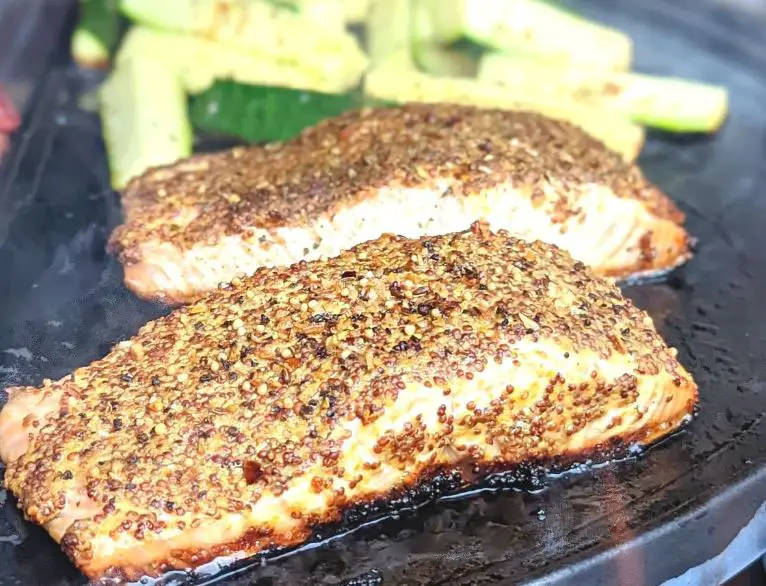Low Sodium Salmon Recipes
Introduction to Low Sodium Diets and Salmon
Indulge in the flavors of the sea with our heart-healthy Low Sodium Salmon Recipe. Perfect for those looking to enjoy the richness of salmon without the added sodium, this recipe is a delightful blend of nutrition and taste. Whether you’re a seasoned chef or a beginner in the kitchen, this Low Sodium Salmon Recipe is straightforward and sure to impress. Packed with the goodness of fresh herbs and spices, it’s a culinary delight that doesn’t compromise on health.
Understanding Sodium in Our Diet
The average diet often exceeds the recommended sodium intake, primarily due to processed foods. High sodium levels can lead to serious health issues like heart disease and stroke. It’s essential to understand the sources of sodium and the risks associated with high intake. For more information on low sodium diets, visit Mayo Clinic – Low Sodium Diet.
Why Choose Low Sodium Salmon Recipes?
- Nutritional benefits: Salmon is a powerhouse of omega-3 fatty acids, which are beneficial for heart health.
- Heart health: A low sodium diet can significantly reduce the risk of heart diseases.
Selecting the Right Salmon for Low Sodium Recipes
Choosing the right type of salmon is key to a healthy meal:
- Types of salmon: Wild-caught and farmed salmon have different nutritional profiles.
- Fresh vs. frozen: Both can be healthy options, but check for added sodium in frozen products.
Preparation Tips for Low Sodium Salmon Dishes
Proper preparation can enhance the flavor without adding extra sodium:
- Marinating techniques: Use herbs, spices, and citrus juices.
- Cooking methods: Grilling, baking, or steaming are ideal for retaining flavors.
Ingredients
- 4 fresh salmon fillets (6 ounces each)
- 2 tablespoons of olive oil
- 1 lemon, zested and juiced
- 2 cloves of garlic, minced
- 1 teaspoon of freshly ground black pepper
- 1 tablespoon of fresh dill, chopped
- 1 tablespoon of fresh parsley, chopped
- Lemon slices, for garnish
Directions
- Preheat the Oven: Preheat your oven to 375°F (190°C). This moderate temperature is perfect for baking salmon.
- Prepare the Marinade: In a small bowl, combine the olive oil, lemon zest, lemon juice, minced garlic, black pepper, dill, and parsley. This mixture will infuse the salmon with flavor without the need for added salt.
- Marinate the Salmon: Place the salmon fillets in a shallow dish. Pour the marinade over the salmon, ensuring each fillet is well-coated. Let it marinate for about 15 minutes at room temperature. This step allows the salmon to absorb the flavors.
- Bake the Salmon: Transfer the salmon fillets to a baking dish. Bake in the preheated oven for about 15-20 minutes, or until the salmon flakes easily with a fork. The exact cooking time may vary depending on the thickness of the fillets.
- Garnish and Serve: Once done, remove the salmon from the oven. Garnish each fillet with a slice of lemon and a sprinkle of fresh herbs. This adds a refreshing touch to the dish.
- Enjoy: Serve the baked salmon with a side of steamed vegetables or a fresh salad for a complete meal.
Top 10 Low Sodium Salmon Recipes
- Herb-Infused Salmon: Fresh herbs and lemon juice create a flavorful marinade.
- Grilled Salmon with Mango Salsa: A refreshing blend of sweet and savory.
- Baked Salmon with Dill: Dill and lemon offer a classic taste.
- Asian-Inspired Glazed Salmon: Soy sauce alternative and ginger for an Asian twist.
- Salmon Patties: Made with fresh salmon and a variety of spices.
- Lemon Pepper Salmon: A simple yet delicious option.
- Honey Mustard Salmon: A sweet and tangy glaze without the sodium.
- Cajun-Style Salmon: Spicy and full of flavor.
- Mediterranean Salmon Bowl: Incorporates healthy fats and vegetables.
- Salmon with Roasted Vegetables: A hearty and balanced meal.
Creative Serving Suggestions
- Pairing with sides: Serve with quinoa, brown rice, or steamed vegetables.
- Presentation tips: Garnish with lemon slices and fresh herbs.
Making Low Sodium Salmon Recipes Kid-Friendly
- Adapting recipes: Use mild spices and fun shapes.
- Engaging kids in cooking: Let them help with safe tasks.
FAQs
- What are the best spices to use in low sodium salmon recipes? Herbs like dill, parsley, and thyme are great for adding flavor without sodium. Citrus zest, garlic, and pepper also enhance taste.
- How can I ensure my salmon is low in sodium? Choose fresh or frozen salmon without added salt. Avoid pre-marinated or canned varieties that may contain added sodium.
- Are canned salmon options low in sodium? Some canned salmon can be high in sodium. Look for labels that say “no salt added” or “low sodium.”
Conclusion and Encouragement for Healthy Eating
In summary, our Low Sodium Salmon Recipe offers a perfect balance between health and flavor. It’s an ideal choice for anyone seeking a nutritious meal that’s low in sodium yet high in taste. This recipe not only caters to your health needs but also brings a gourmet experience to your dining table. Remember, eating healthy doesn’t mean you have to sacrifice flavor, and this Low Sodium Salmon Recipe is a testament to that. Give it a try and savor the taste of a meal that’s as good for your body as it is for your palate.
You might find our Chicken of the Woods recipes intriguing, offering a unique twist on traditional poultry dishes. Additionally, our Chicken Cobbler recipe is another heartwarming dish that complements a balanced diet.
Remember, embracing a low sodium diet doesn’t mean compromising on flavor or variety. Our website is a treasure trove of recipes that cater to diverse tastes while prioritizing health. From the richness of salmon to the comfort of chicken, there’s a recipe for every palate. We encourage you to continue exploring and enjoying the vast array of nutritious and delicious options available at oatsrecipes.com.

